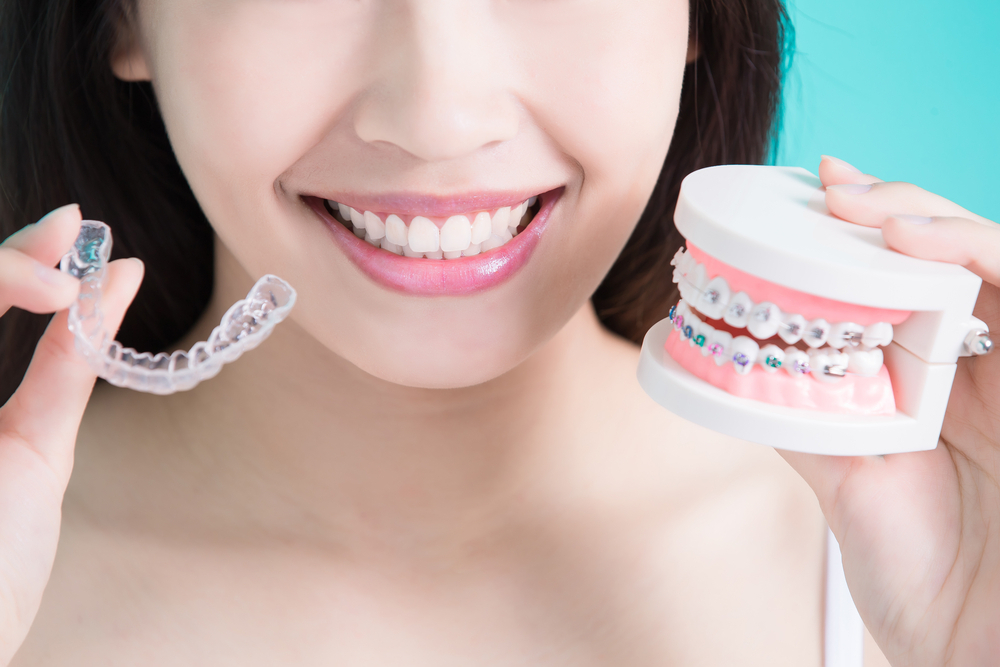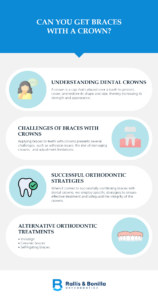Can You Get Braces With a Crown?

If you have a dental crown and are considering braces, you might be wondering if it’s possible to combine these treatments. The good news is that braces can often be successfully applied to teeth with crowns, allowing you to improve your smile and dental alignment without compromise. In this blog post, we’ll explore how braces work with crowns, address common concerns, and discuss what you can expect from the treatment process. So, let’s dive into the details and see how you can achieve the perfect smile you’ve always wanted, even with a crown.
Understanding Dental Crowns
Dental crowns are a common solution for restoring damaged or decayed teeth. A crown is a cap that’s placed over a tooth to protect, cover, and restore its shape and size, thereby increasing its strength and appearance. Crowns are commonly utilized when a tooth is too damaged to be fixed with a simple dental filling or to safeguard a tooth following a root canal surgery.
Crowns can be made from various materials, including:
- Porcelain or Ceramic – These materials are popular because they closely mimic the natural color of teeth and are highly durable.
- Metal Alloys – These include gold, nickel, or chromium, which are known for their strength and longevity and are often used for back teeth where cosmetic appearance is less of a concern.
- Porcelain Fused to Metal – This combines the durability of metal with the aesthetic appeal of porcelain, providing a strong and natural-looking restoration.
Dental crowns play a vital role in dental restoration by enhancing tooth function and appearance. If you have crowns and are considering orthodontic care, understanding these basics will help you discuss your options more effectively with your orthodontist.

How Braces Work
Braces are a highly effective orthodontic treatment used to correct various dental issues, including crooked teeth, crowding, gaps, and misaligned teeth and bites. The basic principle behind braces is relatively straightforward—applying consistent pressure over time to move teeth into their ideal positions slowly.
There are three components in traditional braces:
- Brackets – Small squares bonded directly to the front of each tooth, serving as anchors for braces.
- Archwire – A thin metal wire that connects all the brackets. It’s the main tool through which pressure is applied to the teeth.
- Elastics (Rubber Bands) – Often used in conjunction with braces to apply additional pressure, helping to align the jaw and correct bite issues.
During treatment with braces, your orthodontist will periodically adjust the archwire to ensure it’s effectively guiding your teeth to their correct positions. As the wire strives to return to its pre-formed shape, it applies a pulling or pushing force to the brackets and, consequently, the teeth. This action triggers bone remodeling around the tooth’s roots—bone is resorbed on one side and formed on the other, allowing the teeth to move steadily toward their new alignment.
Braces need adjustments every six to eight weeks. During these appointments, we will adjust or replace the wires and bands to ensure that the teeth continue to move toward the desired position. These regular adjustments are required for braces to function properly and ensure your teeth align correctly.
Challenges of Braces With Crowns
Applying braces when you have dental crowns presents unique challenges, but with careful planning and modern orthodontic techniques, these can be effectively managed.
Here’s what to consider when combining braces with crowns:
- Adhesion Issues – Brackets typically attach to natural teeth with a strong bonding material. Attaching these brackets to a smooth crown surface, especially those made of porcelain or ceramic, requires special care.
- Risk of Damage – There is a slight risk that the crown may be damaged when brackets are attached or removed. We will take extra care to minimize this risk and will monitor the crowns closely throughout your orthodontic treatment.
- Adjustment Limitations – Crowns are fixed prosthetics that do not respond to pressure in the same way as natural teeth. This can limit how much a tooth with a crown can be moved compared to its natural neighbors.
- Collaboration with Dentist – It’s important for us to communicate and collaborate with your dentist. If a crown becomes damaged or needs replacement during orthodontic treatment, we need to work together to ensure continuity of care.
- Custom Adjustments – Your treatment plan will require adjustments to accommodate the presence of crowns.
Despite these challenges, many people with crowns successfully undergo orthodontic treatment. With the right approach, braces can effectively improve your dental alignment and smile aesthetics while keeping your crowns intact. Always discuss your specific needs and concerns with us so we can tailor the treatment to suit your individual situation.
Successful Orthodontic Strategies
When it comes to successfully combining braces with dental crowns, we employ specific strategies to ensure effective treatment and safeguard the integrity of the crowns. Here’s a look at some successful orthodontic strategies used in these cases:
- Specialized Adhesives – We use adhesives specially formulated to grip the materials of dental crowns, such as porcelain or ceramic. This ensures that brackets adhere securely without damaging the crown during attachment or removal.
- Alternative Bracket Placement – Sometimes, brackets are placed on adjacent natural teeth rather than directly on the crowns. This can effectively move teeth while minimizing the risk to the crowned teeth.
- Use of Auxiliary Appliances – In some cases, we may incorporate other dental appliances, like plastic aligners or retainers, which can help adjust the bite and alignment without placing undue stress on crowned teeth.
- Gentle Adjustment Techniques – We may opt for gentler and more gradual adjustments in patients with crowns to prevent excessive force that could damage the crowns or the underlying dental work.
- Regular Monitoring – Regular and detailed check-ups are crucial. These allow us to monitor the progress of the teeth movement and the condition of the crowns, making timely adjustments to the treatment plan as necessary.
By employing these strategies, we can effectively manage the challenges of applying braces to teeth with crowns, ensuring that patients achieve their desired dental alignment and a beautiful smile.
Preparing for Braces with Crowns
Preparing for braces when you have dental crowns involves a few extra steps to ensure that your orthodontic treatment is both effective and safe for your crowns.
- Initial Consultation – We will assess the condition of your crowns and the overall alignment of your teeth to develop a suitable treatment plan. This might include taking X-rays and digital scans to get a precise view of your teeth and underlying bone structure.
- Visit Your Dentist – Before starting orthodontic treatment, it’s a good idea to have a dental check-up. Your dentist can ensure that your crowns and any other dental restorations are in good condition and able to withstand the pressures of braces.
- Understand Your Options – We will explain the different types of braces and other orthodontic appliances that might be suitable for you. We will also discuss any risks associated with placing braces on crowned teeth, helping you make an informed decision.
- Customized Treatment Planning – Based on the initial assessments, we will create a customized treatment plan that considers the presence of your crowns. This plan may include specific types of brackets, specialized adhesives, or alternative placement strategies to minimize any risk to your dental crowns.
- Oral Hygiene Preparation – Good oral health is essential when you have braces, as it helps prevent tooth decay and gum disease around both your natural teeth and crowns. Invest in tools like interdental brushes, water flossers, or orthodontic floss to keep your teeth and braces clean.
By carefully preparing for braces with crowns, you ensure the best possible outcomes for your orthodontic treatment. Your orthodontist and dentist will work together to provide you with a clear path forward, helping you achieve a healthier, more confident smile.
Alternative Orthodontic Treatments
For those looking for a less visible orthodontic solution, there are several alternative treatments to traditional metal braces that can be just as effective. Exploring these orthodontic treatment options can help you find the best fit for your dental needs and lifestyle:
- Invisalign – Clear aligners like Invisalign offer a discreet way to correct misaligned teeth. These custom-made, transparent trays are virtually invisible and can be removed for eating, drinking, and cleaning your teeth. They are an excellent option for both crown-bearing teeth and natural teeth, as they apply gentle pressure without the need for brackets and wires.
- Ceramic Braces – These braces function like traditional metal braces but use brackets that are either clear or the same color as your natural teeth. This makes them less noticeable, blending more seamlessly with your natural smile while providing the same effectiveness in treating misalignments.
- Self-Ligating Braces – These braces use a slide mechanism that holds the wire, allowing it to move naturally with the teeth as they realign. This method reduces the amount of pressure being exerted, making them a more comfortable option for people with sensitive teeth or crowns.
Whether you opt for clear aligners, ceramic braces, or self-ligating braces, there is a solution that can effectively help achieve a straighter smile without compromising the integrity of your crowns.
At Rallis & Bonilla Orthodontics, we are committed to providing exceptional orthodontic care tailored to your unique needs, including for those with dental crowns. With three convenient locations at North Star, 84th Street, and Yankee Hill, our experienced team is ready to guide you through your journey to a healthier, more attractive smile.
We offer a range of orthodontic solutions, including traditional braces and innovative alternatives like Invisalign, to ensure that we have the right option for everyone. Visit us at any of our locations to explore how we can transform your smile with confidence and care. Let Rallis & Bonilla Orthodontics be your partner in achieving the smile you’ve always dreamed of.